Analysis of SASOL Limited's Global Business Environment Report
VerifiedAdded on 2023/01/18
|11
|3345
|85
Report
AI Summary
This report provides a comprehensive analysis of SASOL Limited's global business environment. It begins with an introduction to globalization and its driving factors, followed by a PESTLE analysis. The report then delves into the company's structure, culture, and governance using the McKinsey 7S model, and evaluates ethical and sustainable factors. It applies Hofstede’s Dimensions of culture to assess globalization's influence and examines effective decision-making in a global context. Strategies for internationalization are discussed, along with recommendations for overcoming barriers to international market entry. The report highlights key aspects of SASOL's operations, including its matrix structure, ethical considerations, and decision-making processes, providing a detailed overview of the challenges and opportunities in the global market.
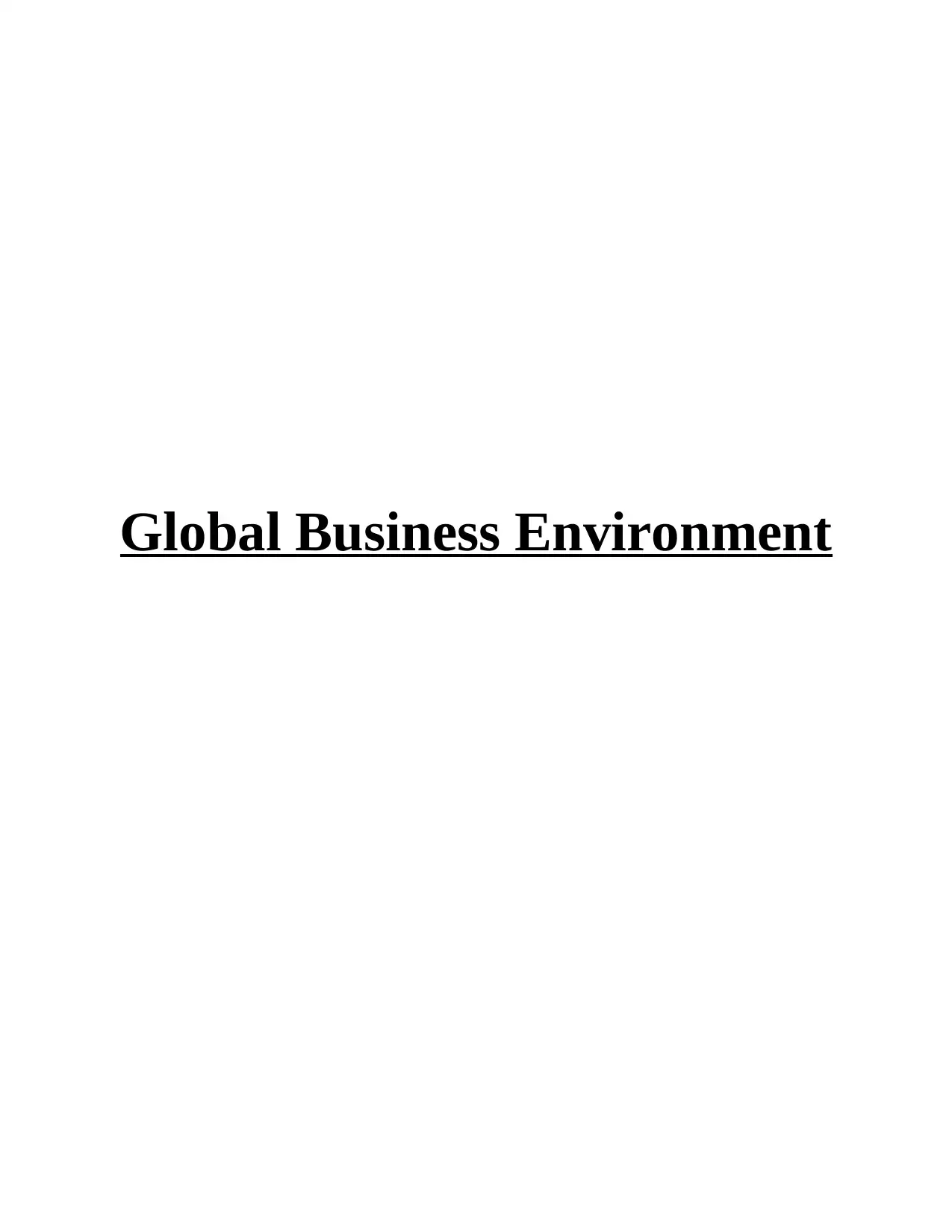
Global Business Environment
Paraphrase This Document
Need a fresh take? Get an instant paraphrase of this document with our AI Paraphraser
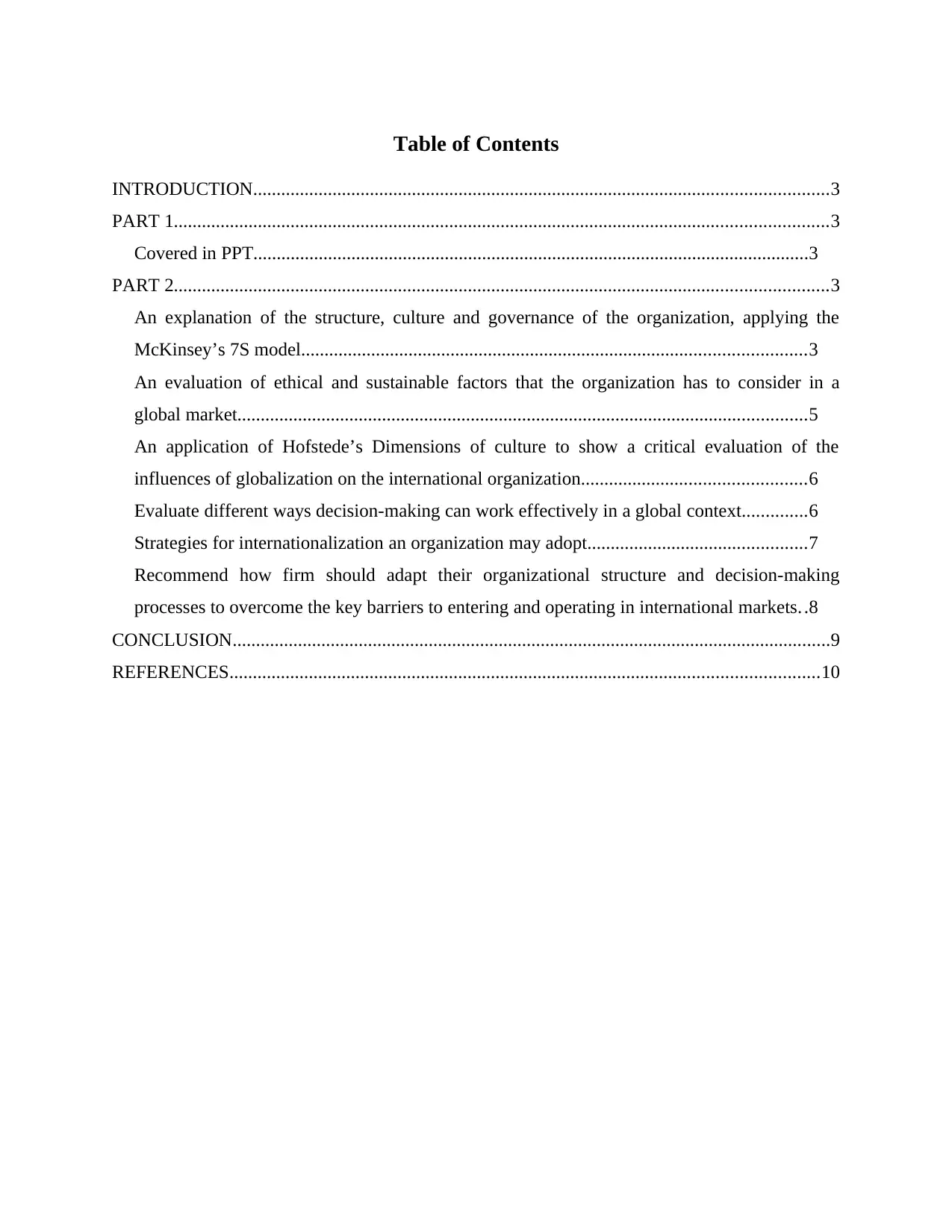
Table of Contents
INTRODUCTION...........................................................................................................................3
PART 1............................................................................................................................................3
Covered in PPT.......................................................................................................................3
PART 2............................................................................................................................................3
An explanation of the structure, culture and governance of the organization, applying the
McKinsey’s 7S model............................................................................................................3
An evaluation of ethical and sustainable factors that the organization has to consider in a
global market..........................................................................................................................5
An application of Hofstede’s Dimensions of culture to show a critical evaluation of the
influences of globalization on the international organization................................................6
Evaluate different ways decision-making can work effectively in a global context..............6
Strategies for internationalization an organization may adopt...............................................7
Recommend how firm should adapt their organizational structure and decision-making
processes to overcome the key barriers to entering and operating in international markets..8
CONCLUSION................................................................................................................................9
REFERENCES..............................................................................................................................10
INTRODUCTION...........................................................................................................................3
PART 1............................................................................................................................................3
Covered in PPT.......................................................................................................................3
PART 2............................................................................................................................................3
An explanation of the structure, culture and governance of the organization, applying the
McKinsey’s 7S model............................................................................................................3
An evaluation of ethical and sustainable factors that the organization has to consider in a
global market..........................................................................................................................5
An application of Hofstede’s Dimensions of culture to show a critical evaluation of the
influences of globalization on the international organization................................................6
Evaluate different ways decision-making can work effectively in a global context..............6
Strategies for internationalization an organization may adopt...............................................7
Recommend how firm should adapt their organizational structure and decision-making
processes to overcome the key barriers to entering and operating in international markets..8
CONCLUSION................................................................................................................................9
REFERENCES..............................................................................................................................10
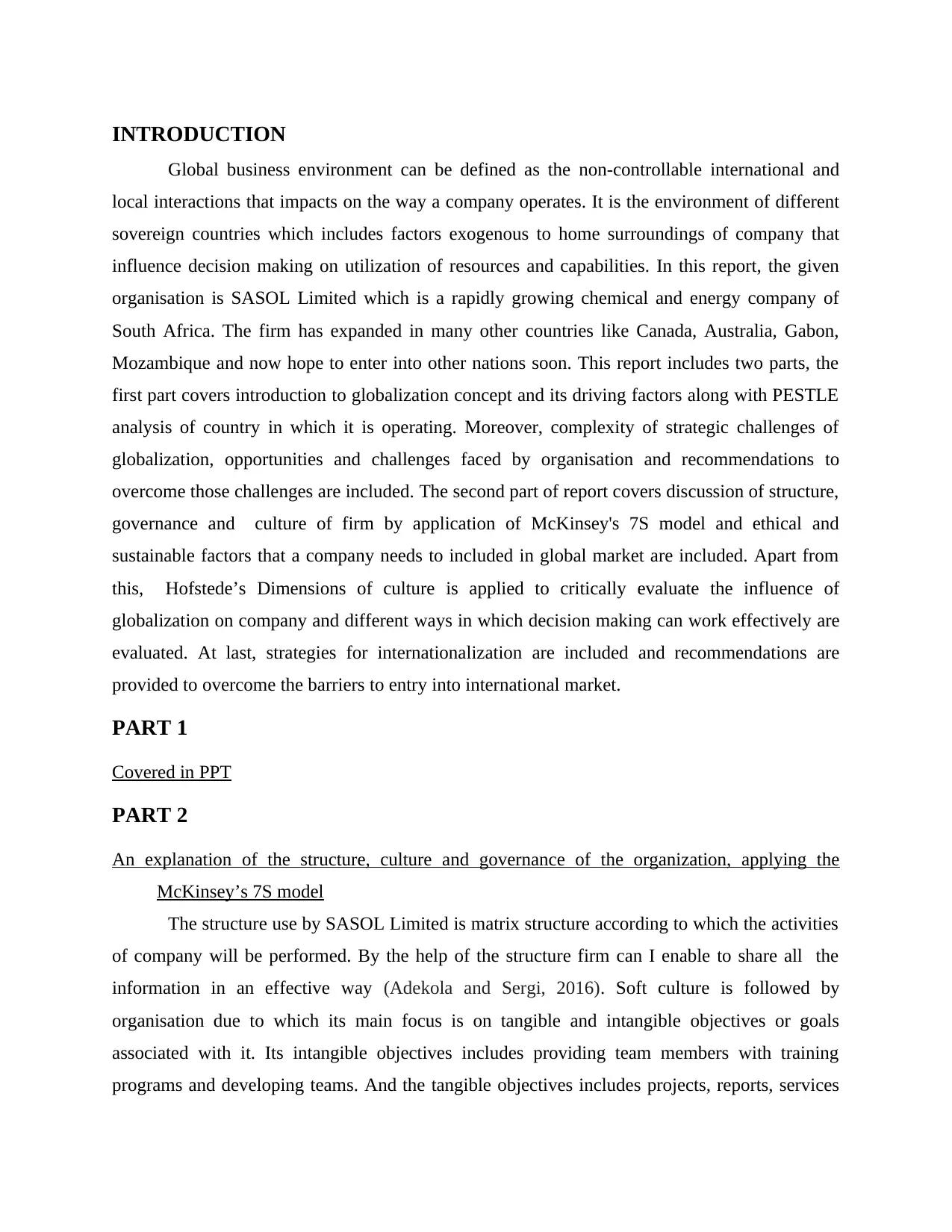
INTRODUCTION
Global business environment can be defined as the non-controllable international and
local interactions that impacts on the way a company operates. It is the environment of different
sovereign countries which includes factors exogenous to home surroundings of company that
influence decision making on utilization of resources and capabilities. In this report, the given
organisation is SASOL Limited which is a rapidly growing chemical and energy company of
South Africa. The firm has expanded in many other countries like Canada, Australia, Gabon,
Mozambique and now hope to enter into other nations soon. This report includes two parts, the
first part covers introduction to globalization concept and its driving factors along with PESTLE
analysis of country in which it is operating. Moreover, complexity of strategic challenges of
globalization, opportunities and challenges faced by organisation and recommendations to
overcome those challenges are included. The second part of report covers discussion of structure,
governance and culture of firm by application of McKinsey's 7S model and ethical and
sustainable factors that a company needs to included in global market are included. Apart from
this, Hofstede’s Dimensions of culture is applied to critically evaluate the influence of
globalization on company and different ways in which decision making can work effectively are
evaluated. At last, strategies for internationalization are included and recommendations are
provided to overcome the barriers to entry into international market.
PART 1
Covered in PPT
PART 2
An explanation of the structure, culture and governance of the organization, applying the
McKinsey’s 7S model
The structure use by SASOL Limited is matrix structure according to which the activities
of company will be performed. By the help of the structure firm can I enable to share all the
information in an effective way (Adekola and Sergi, 2016). Soft culture is followed by
organisation due to which its main focus is on tangible and intangible objectives or goals
associated with it. Its intangible objectives includes providing team members with training
programs and developing teams. And the tangible objectives includes projects, reports, services
Global business environment can be defined as the non-controllable international and
local interactions that impacts on the way a company operates. It is the environment of different
sovereign countries which includes factors exogenous to home surroundings of company that
influence decision making on utilization of resources and capabilities. In this report, the given
organisation is SASOL Limited which is a rapidly growing chemical and energy company of
South Africa. The firm has expanded in many other countries like Canada, Australia, Gabon,
Mozambique and now hope to enter into other nations soon. This report includes two parts, the
first part covers introduction to globalization concept and its driving factors along with PESTLE
analysis of country in which it is operating. Moreover, complexity of strategic challenges of
globalization, opportunities and challenges faced by organisation and recommendations to
overcome those challenges are included. The second part of report covers discussion of structure,
governance and culture of firm by application of McKinsey's 7S model and ethical and
sustainable factors that a company needs to included in global market are included. Apart from
this, Hofstede’s Dimensions of culture is applied to critically evaluate the influence of
globalization on company and different ways in which decision making can work effectively are
evaluated. At last, strategies for internationalization are included and recommendations are
provided to overcome the barriers to entry into international market.
PART 1
Covered in PPT
PART 2
An explanation of the structure, culture and governance of the organization, applying the
McKinsey’s 7S model
The structure use by SASOL Limited is matrix structure according to which the activities
of company will be performed. By the help of the structure firm can I enable to share all the
information in an effective way (Adekola and Sergi, 2016). Soft culture is followed by
organisation due to which its main focus is on tangible and intangible objectives or goals
associated with it. Its intangible objectives includes providing team members with training
programs and developing teams. And the tangible objectives includes projects, reports, services
⊘ This is a preview!⊘
Do you want full access?
Subscribe today to unlock all pages.

Trusted by 1+ million students worldwide
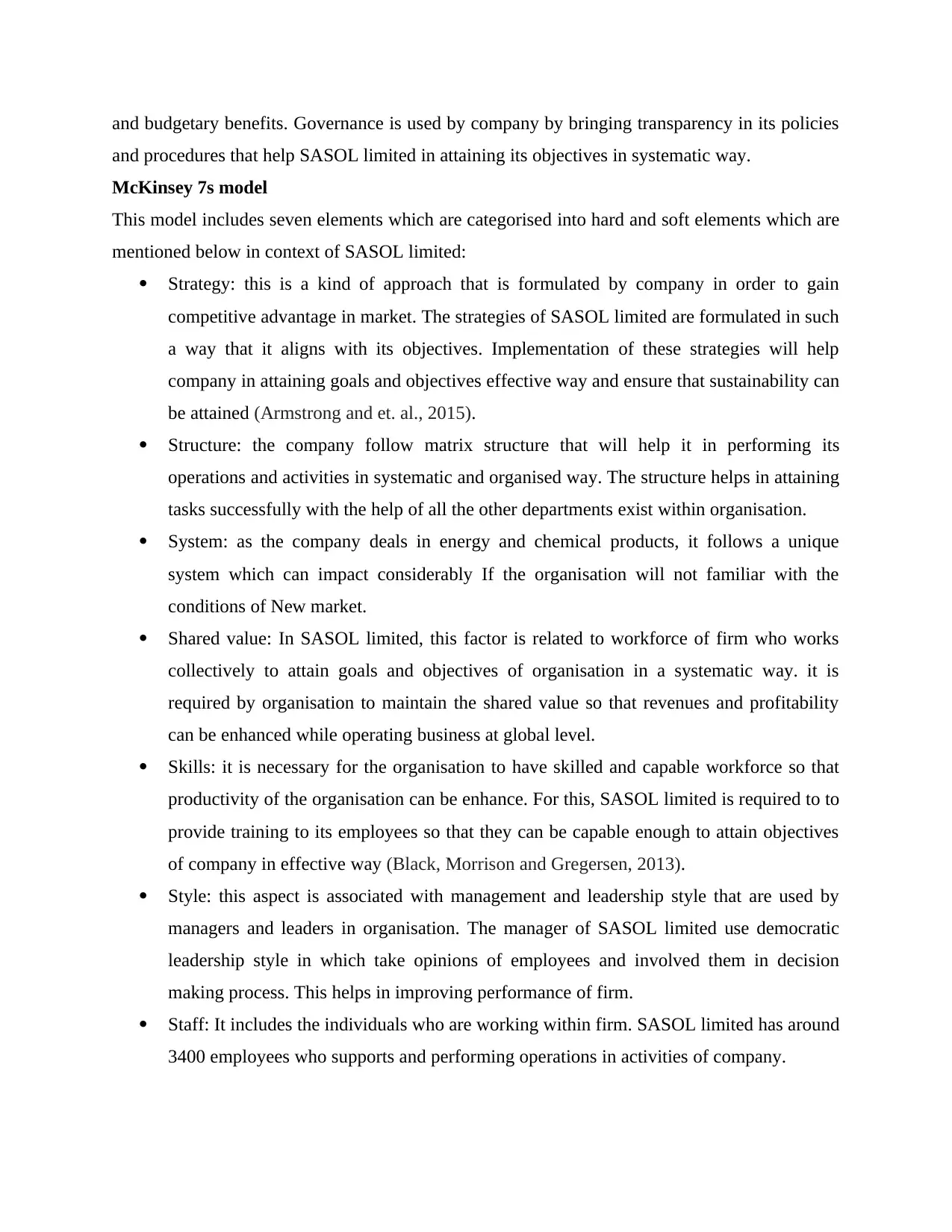
and budgetary benefits. Governance is used by company by bringing transparency in its policies
and procedures that help SASOL limited in attaining its objectives in systematic way.
McKinsey 7s model
This model includes seven elements which are categorised into hard and soft elements which are
mentioned below in context of SASOL limited:
Strategy: this is a kind of approach that is formulated by company in order to gain
competitive advantage in market. The strategies of SASOL limited are formulated in such
a way that it aligns with its objectives. Implementation of these strategies will help
company in attaining goals and objectives effective way and ensure that sustainability can
be attained (Armstrong and et. al., 2015).
Structure: the company follow matrix structure that will help it in performing its
operations and activities in systematic and organised way. The structure helps in attaining
tasks successfully with the help of all the other departments exist within organisation.
System: as the company deals in energy and chemical products, it follows a unique
system which can impact considerably If the organisation will not familiar with the
conditions of New market.
Shared value: In SASOL limited, this factor is related to workforce of firm who works
collectively to attain goals and objectives of organisation in a systematic way. it is
required by organisation to maintain the shared value so that revenues and profitability
can be enhanced while operating business at global level.
Skills: it is necessary for the organisation to have skilled and capable workforce so that
productivity of the organisation can be enhance. For this, SASOL limited is required to to
provide training to its employees so that they can be capable enough to attain objectives
of company in effective way (Black, Morrison and Gregersen, 2013).
Style: this aspect is associated with management and leadership style that are used by
managers and leaders in organisation. The manager of SASOL limited use democratic
leadership style in which take opinions of employees and involved them in decision
making process. This helps in improving performance of firm.
Staff: It includes the individuals who are working within firm. SASOL limited has around
3400 employees who supports and performing operations in activities of company.
and procedures that help SASOL limited in attaining its objectives in systematic way.
McKinsey 7s model
This model includes seven elements which are categorised into hard and soft elements which are
mentioned below in context of SASOL limited:
Strategy: this is a kind of approach that is formulated by company in order to gain
competitive advantage in market. The strategies of SASOL limited are formulated in such
a way that it aligns with its objectives. Implementation of these strategies will help
company in attaining goals and objectives effective way and ensure that sustainability can
be attained (Armstrong and et. al., 2015).
Structure: the company follow matrix structure that will help it in performing its
operations and activities in systematic and organised way. The structure helps in attaining
tasks successfully with the help of all the other departments exist within organisation.
System: as the company deals in energy and chemical products, it follows a unique
system which can impact considerably If the organisation will not familiar with the
conditions of New market.
Shared value: In SASOL limited, this factor is related to workforce of firm who works
collectively to attain goals and objectives of organisation in a systematic way. it is
required by organisation to maintain the shared value so that revenues and profitability
can be enhanced while operating business at global level.
Skills: it is necessary for the organisation to have skilled and capable workforce so that
productivity of the organisation can be enhance. For this, SASOL limited is required to to
provide training to its employees so that they can be capable enough to attain objectives
of company in effective way (Black, Morrison and Gregersen, 2013).
Style: this aspect is associated with management and leadership style that are used by
managers and leaders in organisation. The manager of SASOL limited use democratic
leadership style in which take opinions of employees and involved them in decision
making process. This helps in improving performance of firm.
Staff: It includes the individuals who are working within firm. SASOL limited has around
3400 employees who supports and performing operations in activities of company.
Paraphrase This Document
Need a fresh take? Get an instant paraphrase of this document with our AI Paraphraser
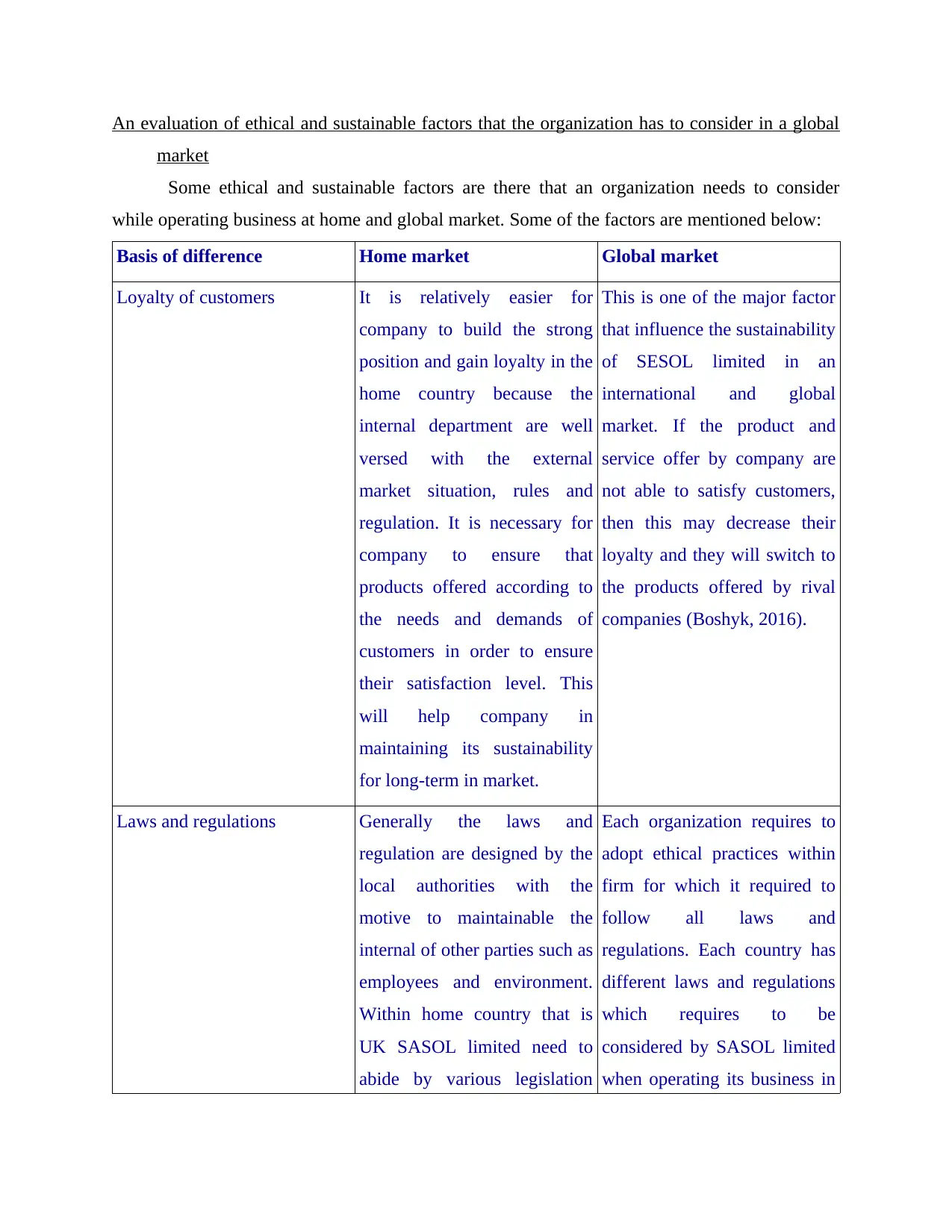
An evaluation of ethical and sustainable factors that the organization has to consider in a global
market
Some ethical and sustainable factors are there that an organization needs to consider
while operating business at home and global market. Some of the factors are mentioned below:
Basis of difference Home market Global market
Loyalty of customers It is relatively easier for
company to build the strong
position and gain loyalty in the
home country because the
internal department are well
versed with the external
market situation, rules and
regulation. It is necessary for
company to ensure that
products offered according to
the needs and demands of
customers in order to ensure
their satisfaction level. This
will help company in
maintaining its sustainability
for long-term in market.
This is one of the major factor
that influence the sustainability
of SESOL limited in an
international and global
market. If the product and
service offer by company are
not able to satisfy customers,
then this may decrease their
loyalty and they will switch to
the products offered by rival
companies (Boshyk, 2016).
Laws and regulations Generally the laws and
regulation are designed by the
local authorities with the
motive to maintainable the
internal of other parties such as
employees and environment.
Within home country that is
UK SASOL limited need to
abide by various legislation
Each organization requires to
adopt ethical practices within
firm for which it required to
follow all laws and
regulations. Each country has
different laws and regulations
which requires to be
considered by SASOL limited
when operating its business in
market
Some ethical and sustainable factors are there that an organization needs to consider
while operating business at home and global market. Some of the factors are mentioned below:
Basis of difference Home market Global market
Loyalty of customers It is relatively easier for
company to build the strong
position and gain loyalty in the
home country because the
internal department are well
versed with the external
market situation, rules and
regulation. It is necessary for
company to ensure that
products offered according to
the needs and demands of
customers in order to ensure
their satisfaction level. This
will help company in
maintaining its sustainability
for long-term in market.
This is one of the major factor
that influence the sustainability
of SESOL limited in an
international and global
market. If the product and
service offer by company are
not able to satisfy customers,
then this may decrease their
loyalty and they will switch to
the products offered by rival
companies (Boshyk, 2016).
Laws and regulations Generally the laws and
regulation are designed by the
local authorities with the
motive to maintainable the
internal of other parties such as
employees and environment.
Within home country that is
UK SASOL limited need to
abide by various legislation
Each organization requires to
adopt ethical practices within
firm for which it required to
follow all laws and
regulations. Each country has
different laws and regulations
which requires to be
considered by SASOL limited
when operating its business in
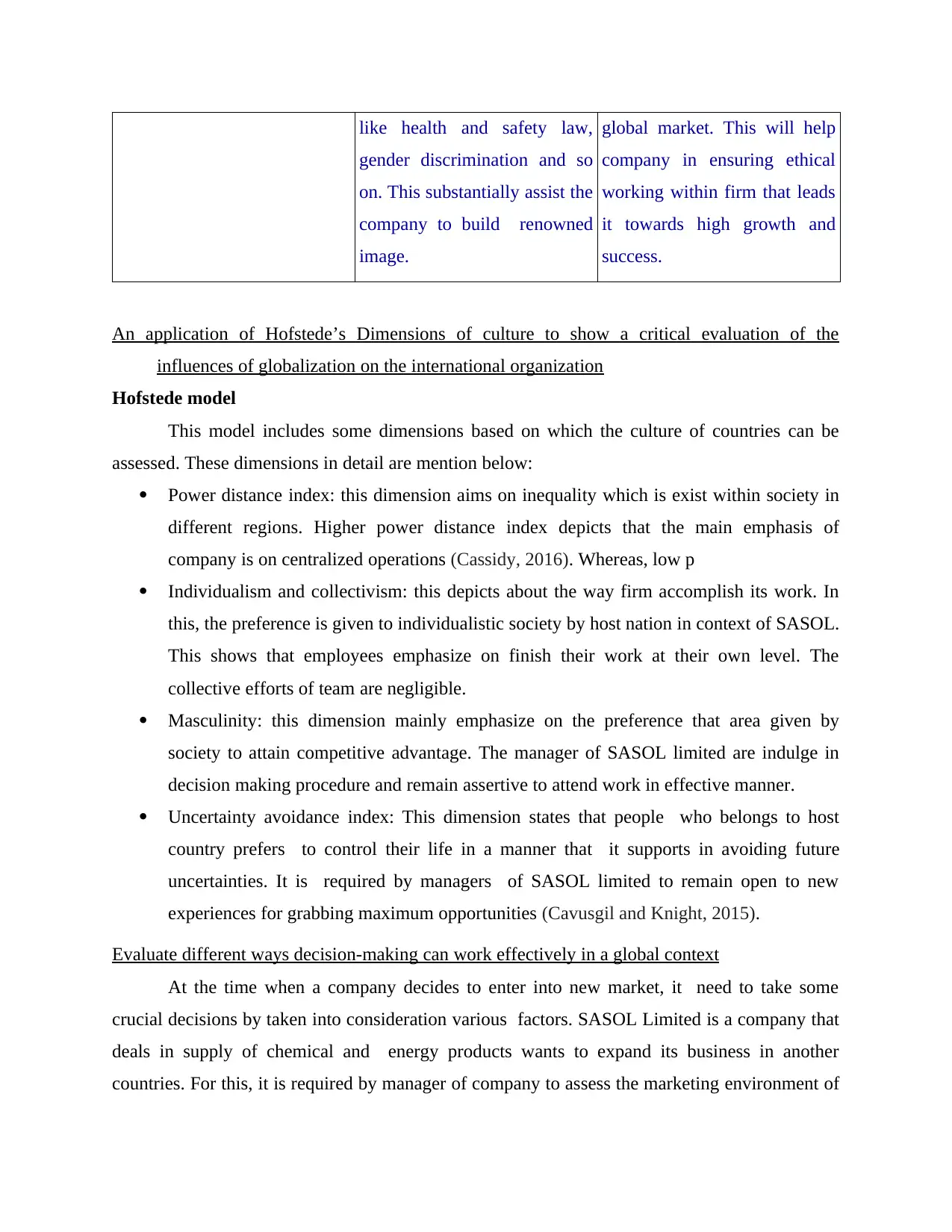
like health and safety law,
gender discrimination and so
on. This substantially assist the
company to build renowned
image.
global market. This will help
company in ensuring ethical
working within firm that leads
it towards high growth and
success.
An application of Hofstede’s Dimensions of culture to show a critical evaluation of the
influences of globalization on the international organization
Hofstede model
This model includes some dimensions based on which the culture of countries can be
assessed. These dimensions in detail are mention below:
Power distance index: this dimension aims on inequality which is exist within society in
different regions. Higher power distance index depicts that the main emphasis of
company is on centralized operations (Cassidy, 2016). Whereas, low p
Individualism and collectivism: this depicts about the way firm accomplish its work. In
this, the preference is given to individualistic society by host nation in context of SASOL.
This shows that employees emphasize on finish their work at their own level. The
collective efforts of team are negligible.
Masculinity: this dimension mainly emphasize on the preference that area given by
society to attain competitive advantage. The manager of SASOL limited are indulge in
decision making procedure and remain assertive to attend work in effective manner.
Uncertainty avoidance index: This dimension states that people who belongs to host
country prefers to control their life in a manner that it supports in avoiding future
uncertainties. It is required by managers of SASOL limited to remain open to new
experiences for grabbing maximum opportunities (Cavusgil and Knight, 2015).
Evaluate different ways decision-making can work effectively in a global context
At the time when a company decides to enter into new market, it need to take some
crucial decisions by taken into consideration various factors. SASOL Limited is a company that
deals in supply of chemical and energy products wants to expand its business in another
countries. For this, it is required by manager of company to assess the marketing environment of
gender discrimination and so
on. This substantially assist the
company to build renowned
image.
global market. This will help
company in ensuring ethical
working within firm that leads
it towards high growth and
success.
An application of Hofstede’s Dimensions of culture to show a critical evaluation of the
influences of globalization on the international organization
Hofstede model
This model includes some dimensions based on which the culture of countries can be
assessed. These dimensions in detail are mention below:
Power distance index: this dimension aims on inequality which is exist within society in
different regions. Higher power distance index depicts that the main emphasis of
company is on centralized operations (Cassidy, 2016). Whereas, low p
Individualism and collectivism: this depicts about the way firm accomplish its work. In
this, the preference is given to individualistic society by host nation in context of SASOL.
This shows that employees emphasize on finish their work at their own level. The
collective efforts of team are negligible.
Masculinity: this dimension mainly emphasize on the preference that area given by
society to attain competitive advantage. The manager of SASOL limited are indulge in
decision making procedure and remain assertive to attend work in effective manner.
Uncertainty avoidance index: This dimension states that people who belongs to host
country prefers to control their life in a manner that it supports in avoiding future
uncertainties. It is required by managers of SASOL limited to remain open to new
experiences for grabbing maximum opportunities (Cavusgil and Knight, 2015).
Evaluate different ways decision-making can work effectively in a global context
At the time when a company decides to enter into new market, it need to take some
crucial decisions by taken into consideration various factors. SASOL Limited is a company that
deals in supply of chemical and energy products wants to expand its business in another
countries. For this, it is required by manager of company to assess the marketing environment of
⊘ This is a preview!⊘
Do you want full access?
Subscribe today to unlock all pages.

Trusted by 1+ million students worldwide
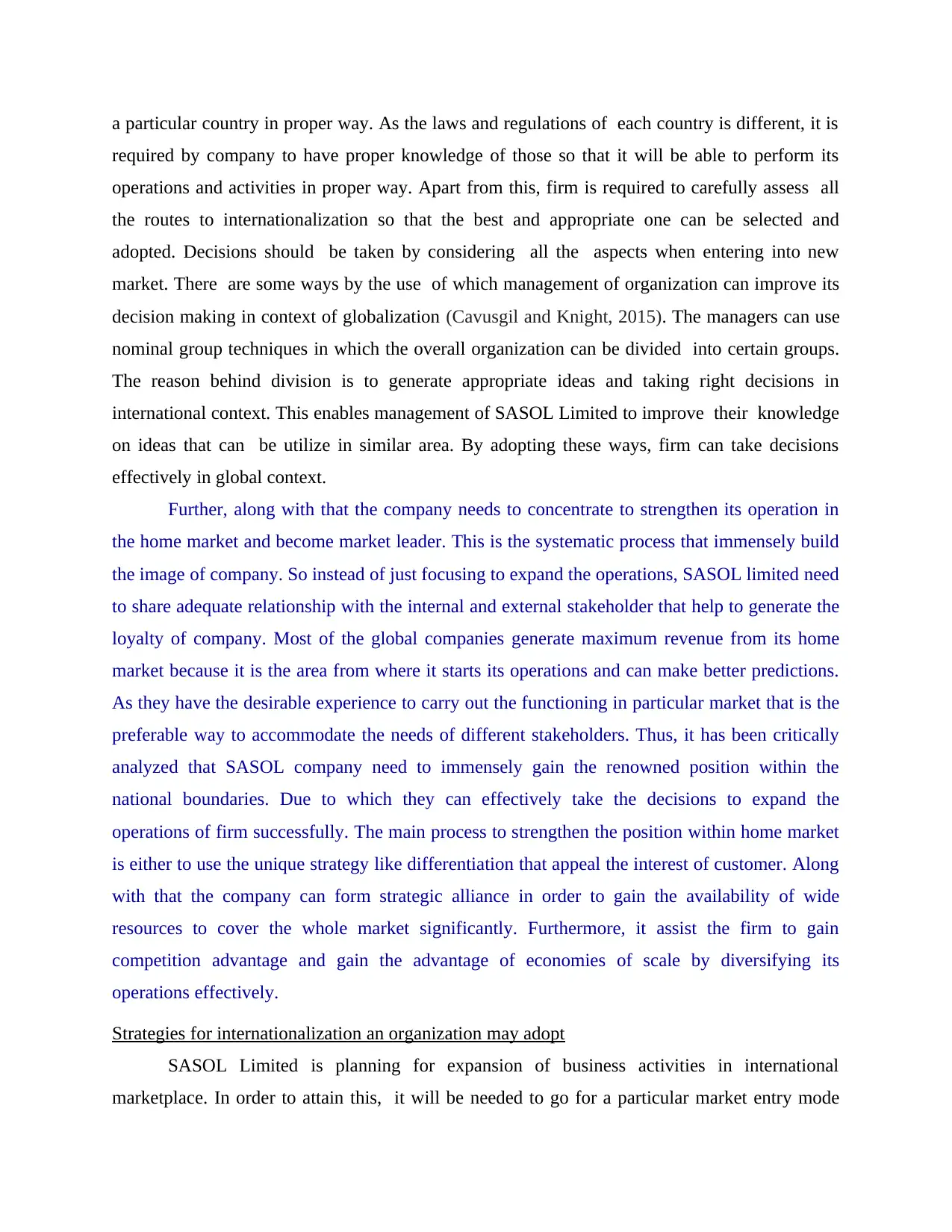
a particular country in proper way. As the laws and regulations of each country is different, it is
required by company to have proper knowledge of those so that it will be able to perform its
operations and activities in proper way. Apart from this, firm is required to carefully assess all
the routes to internationalization so that the best and appropriate one can be selected and
adopted. Decisions should be taken by considering all the aspects when entering into new
market. There are some ways by the use of which management of organization can improve its
decision making in context of globalization (Cavusgil and Knight, 2015). The managers can use
nominal group techniques in which the overall organization can be divided into certain groups.
The reason behind division is to generate appropriate ideas and taking right decisions in
international context. This enables management of SASOL Limited to improve their knowledge
on ideas that can be utilize in similar area. By adopting these ways, firm can take decisions
effectively in global context.
Further, along with that the company needs to concentrate to strengthen its operation in
the home market and become market leader. This is the systematic process that immensely build
the image of company. So instead of just focusing to expand the operations, SASOL limited need
to share adequate relationship with the internal and external stakeholder that help to generate the
loyalty of company. Most of the global companies generate maximum revenue from its home
market because it is the area from where it starts its operations and can make better predictions.
As they have the desirable experience to carry out the functioning in particular market that is the
preferable way to accommodate the needs of different stakeholders. Thus, it has been critically
analyzed that SASOL company need to immensely gain the renowned position within the
national boundaries. Due to which they can effectively take the decisions to expand the
operations of firm successfully. The main process to strengthen the position within home market
is either to use the unique strategy like differentiation that appeal the interest of customer. Along
with that the company can form strategic alliance in order to gain the availability of wide
resources to cover the whole market significantly. Furthermore, it assist the firm to gain
competition advantage and gain the advantage of economies of scale by diversifying its
operations effectively.
Strategies for internationalization an organization may adopt
SASOL Limited is planning for expansion of business activities in international
marketplace. In order to attain this, it will be needed to go for a particular market entry mode
required by company to have proper knowledge of those so that it will be able to perform its
operations and activities in proper way. Apart from this, firm is required to carefully assess all
the routes to internationalization so that the best and appropriate one can be selected and
adopted. Decisions should be taken by considering all the aspects when entering into new
market. There are some ways by the use of which management of organization can improve its
decision making in context of globalization (Cavusgil and Knight, 2015). The managers can use
nominal group techniques in which the overall organization can be divided into certain groups.
The reason behind division is to generate appropriate ideas and taking right decisions in
international context. This enables management of SASOL Limited to improve their knowledge
on ideas that can be utilize in similar area. By adopting these ways, firm can take decisions
effectively in global context.
Further, along with that the company needs to concentrate to strengthen its operation in
the home market and become market leader. This is the systematic process that immensely build
the image of company. So instead of just focusing to expand the operations, SASOL limited need
to share adequate relationship with the internal and external stakeholder that help to generate the
loyalty of company. Most of the global companies generate maximum revenue from its home
market because it is the area from where it starts its operations and can make better predictions.
As they have the desirable experience to carry out the functioning in particular market that is the
preferable way to accommodate the needs of different stakeholders. Thus, it has been critically
analyzed that SASOL company need to immensely gain the renowned position within the
national boundaries. Due to which they can effectively take the decisions to expand the
operations of firm successfully. The main process to strengthen the position within home market
is either to use the unique strategy like differentiation that appeal the interest of customer. Along
with that the company can form strategic alliance in order to gain the availability of wide
resources to cover the whole market significantly. Furthermore, it assist the firm to gain
competition advantage and gain the advantage of economies of scale by diversifying its
operations effectively.
Strategies for internationalization an organization may adopt
SASOL Limited is planning for expansion of business activities in international
marketplace. In order to attain this, it will be needed to go for a particular market entry mode
Paraphrase This Document
Need a fresh take? Get an instant paraphrase of this document with our AI Paraphraser
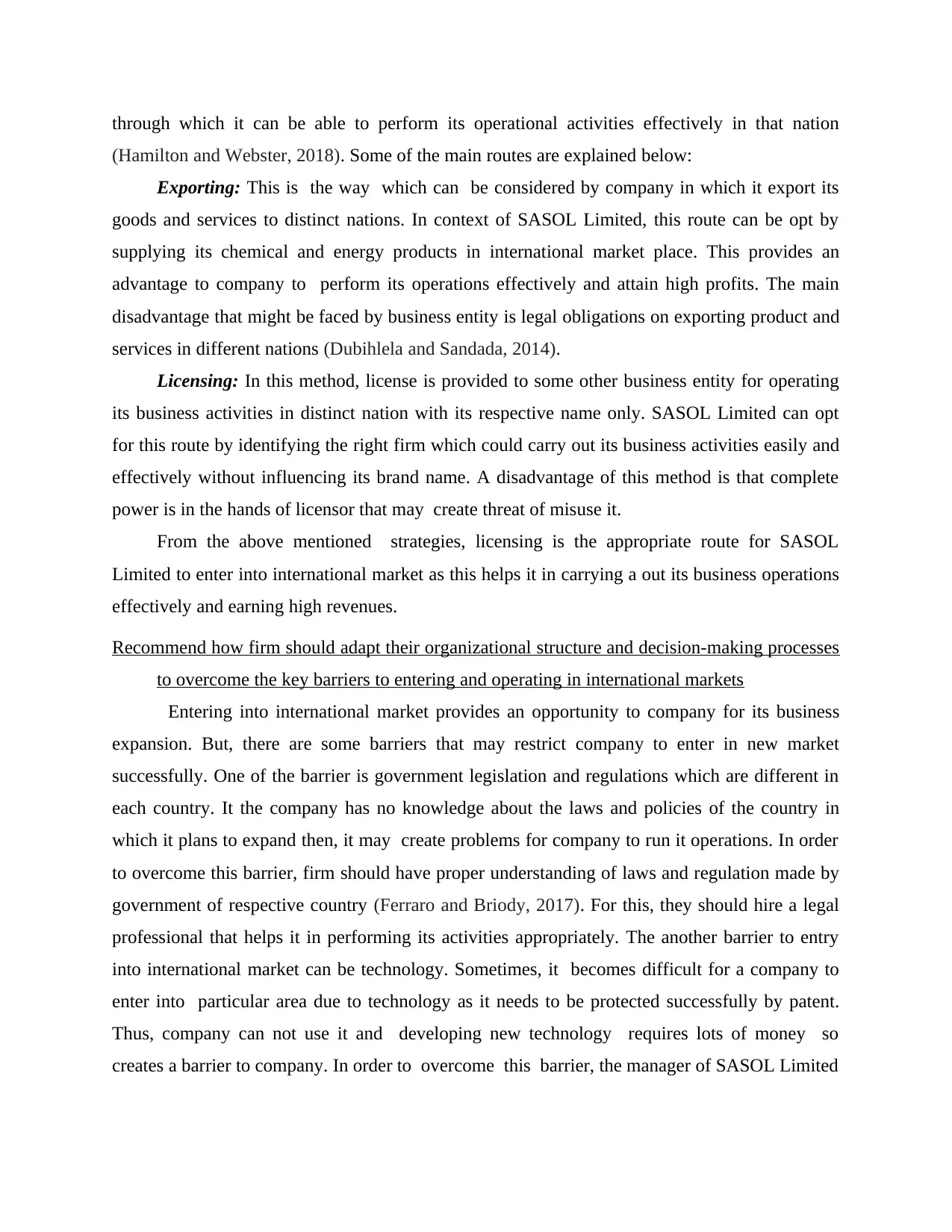
through which it can be able to perform its operational activities effectively in that nation
(Hamilton and Webster, 2018). Some of the main routes are explained below:
Exporting: This is the way which can be considered by company in which it export its
goods and services to distinct nations. In context of SASOL Limited, this route can be opt by
supplying its chemical and energy products in international market place. This provides an
advantage to company to perform its operations effectively and attain high profits. The main
disadvantage that might be faced by business entity is legal obligations on exporting product and
services in different nations (Dubihlela and Sandada, 2014).
Licensing: In this method, license is provided to some other business entity for operating
its business activities in distinct nation with its respective name only. SASOL Limited can opt
for this route by identifying the right firm which could carry out its business activities easily and
effectively without influencing its brand name. A disadvantage of this method is that complete
power is in the hands of licensor that may create threat of misuse it.
From the above mentioned strategies, licensing is the appropriate route for SASOL
Limited to enter into international market as this helps it in carrying a out its business operations
effectively and earning high revenues.
Recommend how firm should adapt their organizational structure and decision-making processes
to overcome the key barriers to entering and operating in international markets
Entering into international market provides an opportunity to company for its business
expansion. But, there are some barriers that may restrict company to enter in new market
successfully. One of the barrier is government legislation and regulations which are different in
each country. It the company has no knowledge about the laws and policies of the country in
which it plans to expand then, it may create problems for company to run it operations. In order
to overcome this barrier, firm should have proper understanding of laws and regulation made by
government of respective country (Ferraro and Briody, 2017). For this, they should hire a legal
professional that helps it in performing its activities appropriately. The another barrier to entry
into international market can be technology. Sometimes, it becomes difficult for a company to
enter into particular area due to technology as it needs to be protected successfully by patent.
Thus, company can not use it and developing new technology requires lots of money so
creates a barrier to company. In order to overcome this barrier, the manager of SASOL Limited
(Hamilton and Webster, 2018). Some of the main routes are explained below:
Exporting: This is the way which can be considered by company in which it export its
goods and services to distinct nations. In context of SASOL Limited, this route can be opt by
supplying its chemical and energy products in international market place. This provides an
advantage to company to perform its operations effectively and attain high profits. The main
disadvantage that might be faced by business entity is legal obligations on exporting product and
services in different nations (Dubihlela and Sandada, 2014).
Licensing: In this method, license is provided to some other business entity for operating
its business activities in distinct nation with its respective name only. SASOL Limited can opt
for this route by identifying the right firm which could carry out its business activities easily and
effectively without influencing its brand name. A disadvantage of this method is that complete
power is in the hands of licensor that may create threat of misuse it.
From the above mentioned strategies, licensing is the appropriate route for SASOL
Limited to enter into international market as this helps it in carrying a out its business operations
effectively and earning high revenues.
Recommend how firm should adapt their organizational structure and decision-making processes
to overcome the key barriers to entering and operating in international markets
Entering into international market provides an opportunity to company for its business
expansion. But, there are some barriers that may restrict company to enter in new market
successfully. One of the barrier is government legislation and regulations which are different in
each country. It the company has no knowledge about the laws and policies of the country in
which it plans to expand then, it may create problems for company to run it operations. In order
to overcome this barrier, firm should have proper understanding of laws and regulation made by
government of respective country (Ferraro and Briody, 2017). For this, they should hire a legal
professional that helps it in performing its activities appropriately. The another barrier to entry
into international market can be technology. Sometimes, it becomes difficult for a company to
enter into particular area due to technology as it needs to be protected successfully by patent.
Thus, company can not use it and developing new technology requires lots of money so
creates a barrier to company. In order to overcome this barrier, the manager of SASOL Limited
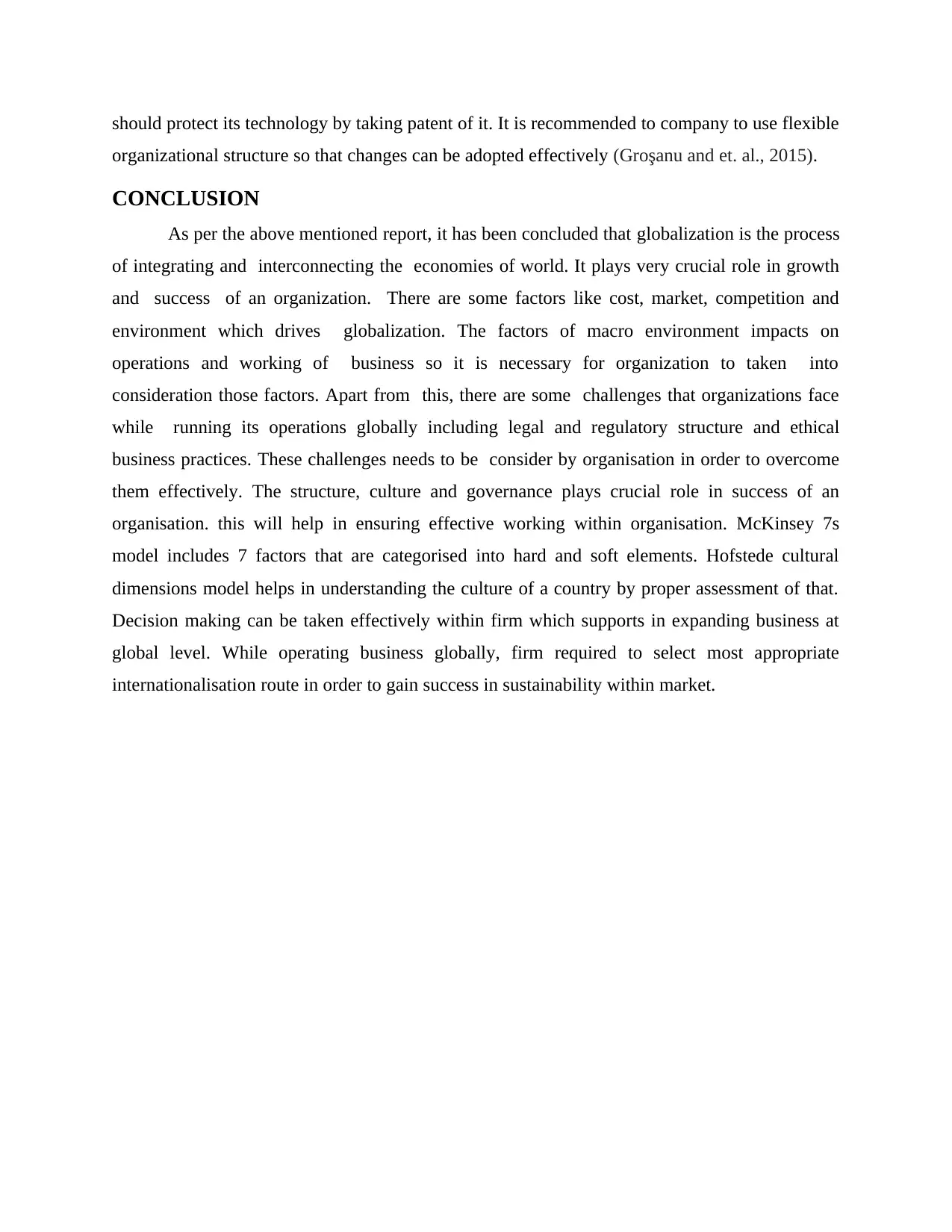
should protect its technology by taking patent of it. It is recommended to company to use flexible
organizational structure so that changes can be adopted effectively (Groşanu and et. al., 2015).
CONCLUSION
As per the above mentioned report, it has been concluded that globalization is the process
of integrating and interconnecting the economies of world. It plays very crucial role in growth
and success of an organization. There are some factors like cost, market, competition and
environment which drives globalization. The factors of macro environment impacts on
operations and working of business so it is necessary for organization to taken into
consideration those factors. Apart from this, there are some challenges that organizations face
while running its operations globally including legal and regulatory structure and ethical
business practices. These challenges needs to be consider by organisation in order to overcome
them effectively. The structure, culture and governance plays crucial role in success of an
organisation. this will help in ensuring effective working within organisation. McKinsey 7s
model includes 7 factors that are categorised into hard and soft elements. Hofstede cultural
dimensions model helps in understanding the culture of a country by proper assessment of that.
Decision making can be taken effectively within firm which supports in expanding business at
global level. While operating business globally, firm required to select most appropriate
internationalisation route in order to gain success in sustainability within market.
organizational structure so that changes can be adopted effectively (Groşanu and et. al., 2015).
CONCLUSION
As per the above mentioned report, it has been concluded that globalization is the process
of integrating and interconnecting the economies of world. It plays very crucial role in growth
and success of an organization. There are some factors like cost, market, competition and
environment which drives globalization. The factors of macro environment impacts on
operations and working of business so it is necessary for organization to taken into
consideration those factors. Apart from this, there are some challenges that organizations face
while running its operations globally including legal and regulatory structure and ethical
business practices. These challenges needs to be consider by organisation in order to overcome
them effectively. The structure, culture and governance plays crucial role in success of an
organisation. this will help in ensuring effective working within organisation. McKinsey 7s
model includes 7 factors that are categorised into hard and soft elements. Hofstede cultural
dimensions model helps in understanding the culture of a country by proper assessment of that.
Decision making can be taken effectively within firm which supports in expanding business at
global level. While operating business globally, firm required to select most appropriate
internationalisation route in order to gain success in sustainability within market.
⊘ This is a preview!⊘
Do you want full access?
Subscribe today to unlock all pages.

Trusted by 1+ million students worldwide
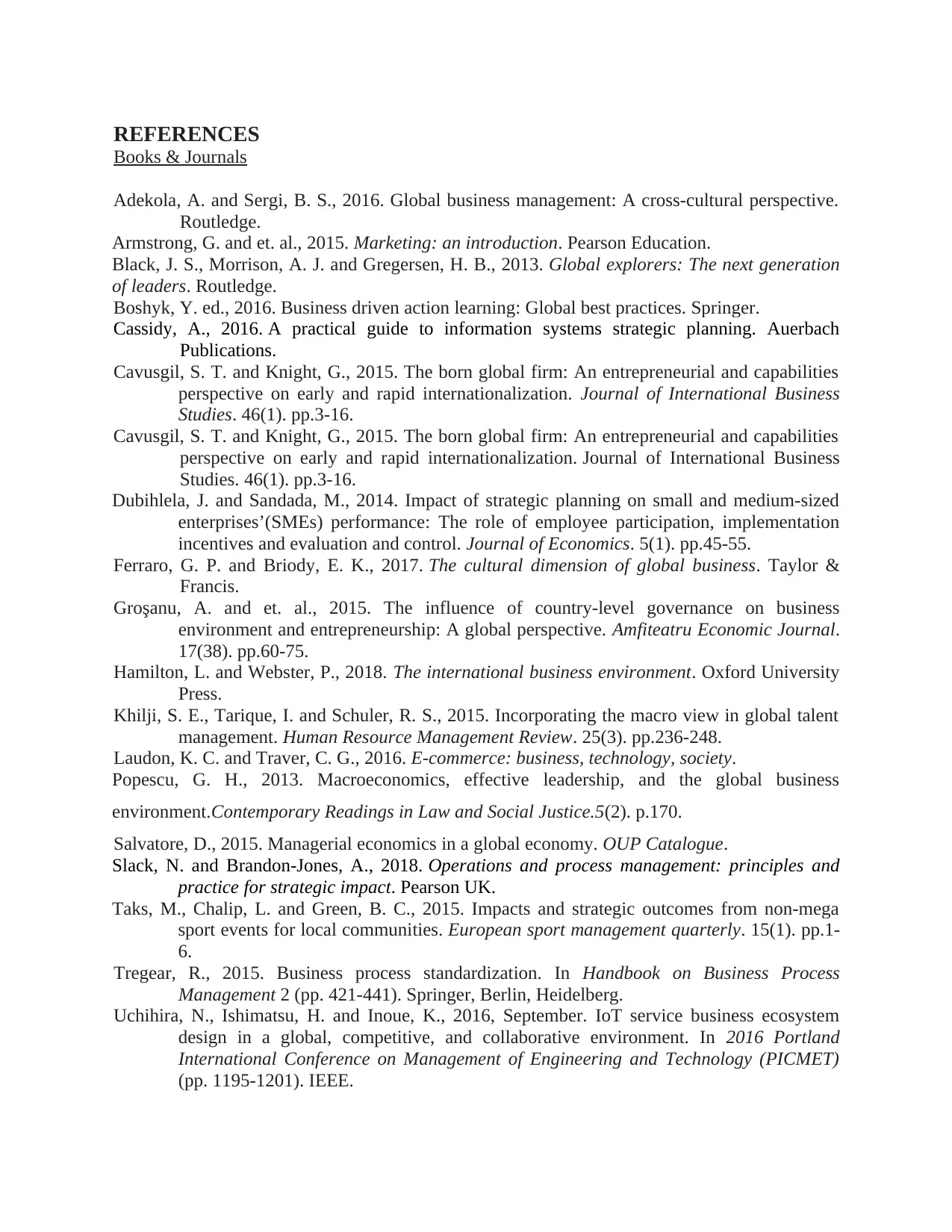
REFERENCES
Books & Journals
Adekola, A. and Sergi, B. S., 2016. Global business management: A cross-cultural perspective.
Routledge.
Armstrong, G. and et. al., 2015. Marketing: an introduction. Pearson Education.
Black, J. S., Morrison, A. J. and Gregersen, H. B., 2013. Global explorers: The next generation
of leaders. Routledge.
Boshyk, Y. ed., 2016. Business driven action learning: Global best practices. Springer.
Cassidy, A., 2016. A practical guide to information systems strategic planning. Auerbach
Publications.
Cavusgil, S. T. and Knight, G., 2015. The born global firm: An entrepreneurial and capabilities
perspective on early and rapid internationalization. Journal of International Business
Studies. 46(1). pp.3-16.
Cavusgil, S. T. and Knight, G., 2015. The born global firm: An entrepreneurial and capabilities
perspective on early and rapid internationalization. Journal of International Business
Studies. 46(1). pp.3-16.
Dubihlela, J. and Sandada, M., 2014. Impact of strategic planning on small and medium-sized
enterprises’(SMEs) performance: The role of employee participation, implementation
incentives and evaluation and control. Journal of Economics. 5(1). pp.45-55.
Ferraro, G. P. and Briody, E. K., 2017. The cultural dimension of global business. Taylor &
Francis.
Groşanu, A. and et. al., 2015. The influence of country-level governance on business
environment and entrepreneurship: A global perspective. Amfiteatru Economic Journal.
17(38). pp.60-75.
Hamilton, L. and Webster, P., 2018. The international business environment. Oxford University
Press.
Khilji, S. E., Tarique, I. and Schuler, R. S., 2015. Incorporating the macro view in global talent
management. Human Resource Management Review. 25(3). pp.236-248.
Laudon, K. C. and Traver, C. G., 2016. E-commerce: business, technology, society.
Popescu, G. H., 2013. Macroeconomics, effective leadership, and the global business
environment.Contemporary Readings in Law and Social Justice.5(2). p.170.
Salvatore, D., 2015. Managerial economics in a global economy. OUP Catalogue.
Slack, N. and Brandon-Jones, A., 2018. Operations and process management: principles and
practice for strategic impact. Pearson UK.
Taks, M., Chalip, L. and Green, B. C., 2015. Impacts and strategic outcomes from non-mega
sport events for local communities. European sport management quarterly. 15(1). pp.1-
6.
Tregear, R., 2015. Business process standardization. In Handbook on Business Process
Management 2 (pp. 421-441). Springer, Berlin, Heidelberg.
Uchihira, N., Ishimatsu, H. and Inoue, K., 2016, September. IoT service business ecosystem
design in a global, competitive, and collaborative environment. In 2016 Portland
International Conference on Management of Engineering and Technology (PICMET)
(pp. 1195-1201). IEEE.
Books & Journals
Adekola, A. and Sergi, B. S., 2016. Global business management: A cross-cultural perspective.
Routledge.
Armstrong, G. and et. al., 2015. Marketing: an introduction. Pearson Education.
Black, J. S., Morrison, A. J. and Gregersen, H. B., 2013. Global explorers: The next generation
of leaders. Routledge.
Boshyk, Y. ed., 2016. Business driven action learning: Global best practices. Springer.
Cassidy, A., 2016. A practical guide to information systems strategic planning. Auerbach
Publications.
Cavusgil, S. T. and Knight, G., 2015. The born global firm: An entrepreneurial and capabilities
perspective on early and rapid internationalization. Journal of International Business
Studies. 46(1). pp.3-16.
Cavusgil, S. T. and Knight, G., 2015. The born global firm: An entrepreneurial and capabilities
perspective on early and rapid internationalization. Journal of International Business
Studies. 46(1). pp.3-16.
Dubihlela, J. and Sandada, M., 2014. Impact of strategic planning on small and medium-sized
enterprises’(SMEs) performance: The role of employee participation, implementation
incentives and evaluation and control. Journal of Economics. 5(1). pp.45-55.
Ferraro, G. P. and Briody, E. K., 2017. The cultural dimension of global business. Taylor &
Francis.
Groşanu, A. and et. al., 2015. The influence of country-level governance on business
environment and entrepreneurship: A global perspective. Amfiteatru Economic Journal.
17(38). pp.60-75.
Hamilton, L. and Webster, P., 2018. The international business environment. Oxford University
Press.
Khilji, S. E., Tarique, I. and Schuler, R. S., 2015. Incorporating the macro view in global talent
management. Human Resource Management Review. 25(3). pp.236-248.
Laudon, K. C. and Traver, C. G., 2016. E-commerce: business, technology, society.
Popescu, G. H., 2013. Macroeconomics, effective leadership, and the global business
environment.Contemporary Readings in Law and Social Justice.5(2). p.170.
Salvatore, D., 2015. Managerial economics in a global economy. OUP Catalogue.
Slack, N. and Brandon-Jones, A., 2018. Operations and process management: principles and
practice for strategic impact. Pearson UK.
Taks, M., Chalip, L. and Green, B. C., 2015. Impacts and strategic outcomes from non-mega
sport events for local communities. European sport management quarterly. 15(1). pp.1-
6.
Tregear, R., 2015. Business process standardization. In Handbook on Business Process
Management 2 (pp. 421-441). Springer, Berlin, Heidelberg.
Uchihira, N., Ishimatsu, H. and Inoue, K., 2016, September. IoT service business ecosystem
design in a global, competitive, and collaborative environment. In 2016 Portland
International Conference on Management of Engineering and Technology (PICMET)
(pp. 1195-1201). IEEE.
Paraphrase This Document
Need a fresh take? Get an instant paraphrase of this document with our AI Paraphraser
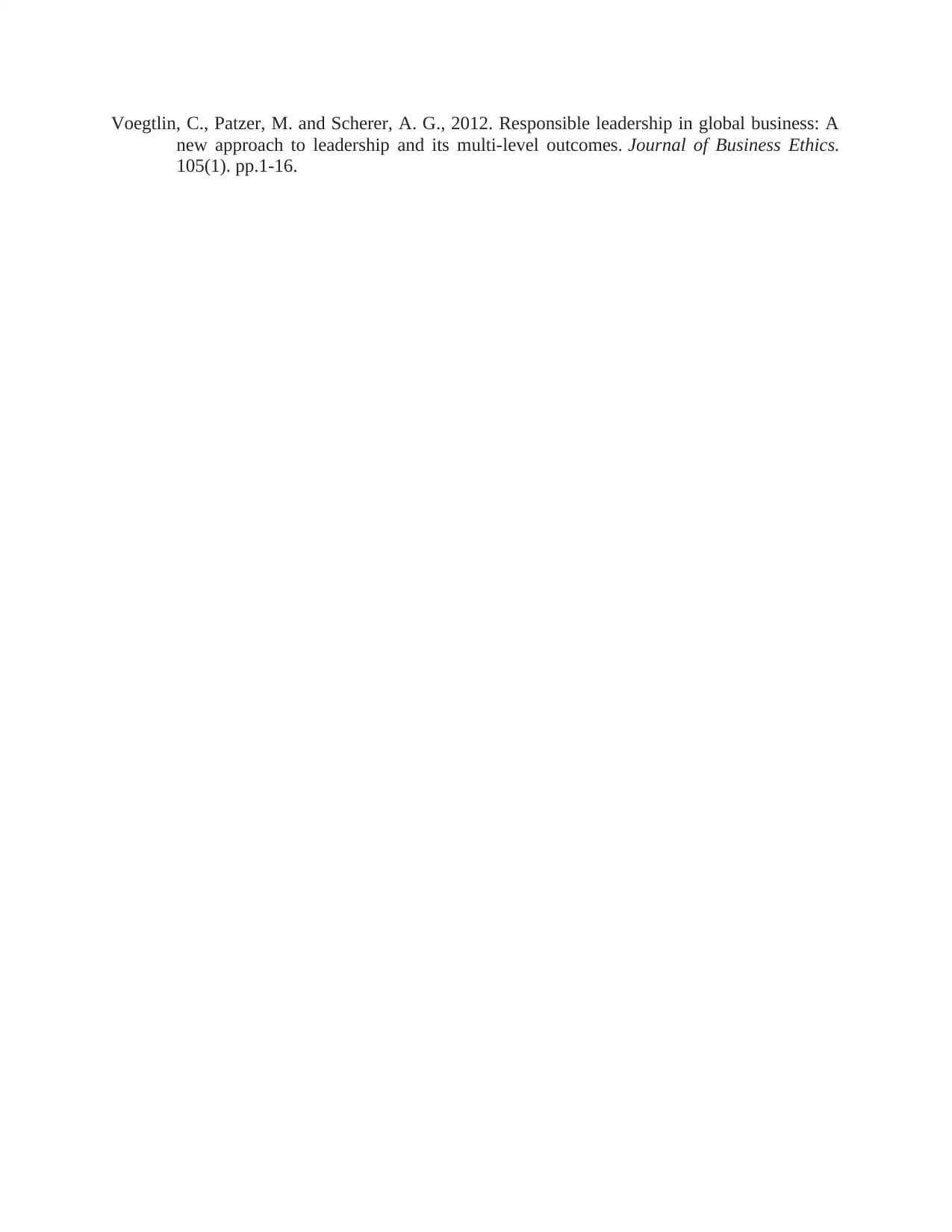
Voegtlin, C., Patzer, M. and Scherer, A. G., 2012. Responsible leadership in global business: A
new approach to leadership and its multi-level outcomes. Journal of Business Ethics.
105(1). pp.1-16.
new approach to leadership and its multi-level outcomes. Journal of Business Ethics.
105(1). pp.1-16.
1 out of 11
Related Documents
Your All-in-One AI-Powered Toolkit for Academic Success.
+13062052269
info@desklib.com
Available 24*7 on WhatsApp / Email
![[object Object]](/_next/static/media/star-bottom.7253800d.svg)
Unlock your academic potential
Copyright © 2020–2025 A2Z Services. All Rights Reserved. Developed and managed by ZUCOL.


